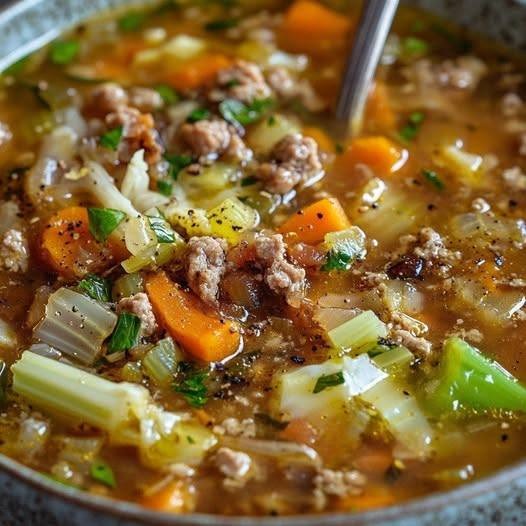🥣 Egg Roll Soup
📝 Introduction
Egg Roll Soup is a nourishing, deconstructed version of the classic Chinese-American egg roll. It combines the beloved flavors of cabbage, pork (or other protein), garlic, ginger, and sesame with a rich, savory broth—without the deep-fried wrapper. This soup offers a lighter, low-carb twist on a takeout favorite while remaining deeply satisfying and flavorful.
🌏 Origin and Cultural Significance
Egg rolls are a staple of Chinese-American cuisine, believed to have evolved from traditional Chinese spring rolls. While not authentically Chinese, they represent the culinary fusion that occurred as Chinese immigrants adapted recipes to American ingredients and tastes. Egg Roll Soup, a modern creation, mirrors the growing trend of transforming comfort foods into healthier, more convenient meals. It resonates with those who love the taste of egg rolls but prefer a nourishing, gluten-free or keto-friendly alternative.
🧂 Ingredients Quantity (Serves 4–6)
- 1 lb ground pork (or ground chicken, turkey, or plant-based meat)
- 1 tbsp sesame oil
- 1 tbsp olive oil
- 1 small onion, diced
- 3 cloves garlic, minced
- 1 tbsp fresh ginger, grated (or 1 tsp ground ginger)
- 4 cups green cabbage, shredded
- 1 cup shredded carrots
- 1 tbsp soy sauce (or tamari for gluten-free)
- 1 tbsp rice vinegar
- 4 cups chicken broth (or vegetable broth)
- Salt and pepper to taste
- Green onions, chopped (for garnish)
🍋 Optional Additions
- Sriracha or chili garlic sauce – for heat
- Water chestnuts – for crunch
- Mung bean sprouts – for extra texture
- Tofu cubes – for added protein
- Mushrooms – umami boost
- A cracked egg, stirred in during simmering for an “egg drop” effect
✅ Tips for Success
- Use fresh aromatics like ginger and garlic for the best flavor.
- Don’t overcook the cabbage—it should retain some bite for that egg roll texture.
- Brown the meat well to develop depth of flavor before adding other ingredients.
- Balance flavors by adjusting soy sauce, vinegar, and spice levels to your taste.
- Make it ahead—flavors deepen over time, making leftovers even better.
🍲 Instructions
- Heat oils in a large pot over medium heat. Add the ground pork and cook until browned and fully cooked, about 6–8 minutes. Break into crumbles.
- Add onion, garlic, and ginger. Sauté for 2–3 minutes until fragrant.
- Stir in shredded cabbage and carrots. Cook for 5 minutes, stirring frequently.
- Add soy sauce and rice vinegar. Mix to coat the vegetables and meat.
- Pour in the chicken broth. Bring to a gentle boil, then reduce heat and simmer for 10–15 minutes.
- Season to taste with salt and pepper.
- Serve hot, garnished with green onions and any optional toppings.
🧾 Description
This Egg Roll Soup is warm, savory, and deeply satisfying. The rich broth carries the essence of traditional egg roll fillings with a fraction of the calories and none of the grease. It’s comforting on a cold night, excellent for meal prep, and adaptable to various dietary needs (low-carb, keto, gluten-free).
🍽️ Nutritional Information (Approximate per serving, based on 6 servings)
- Calories: 250–300
- Protein: 18–22g
- Fat: 15–20g
- Carbohydrates: 8–12g
- Fiber: 2–3g
- Sugars: 3–5g
- Sodium: ~800–1000mg (varies with broth and soy sauce used)
🏁 Conclusion
Egg Roll Soup takes a beloved comfort food and makes it healthier, quicker, and more accessible for everyday cooking. Its flexible nature allows you to tailor it to your personal tastes or dietary goals without compromising flavor.
⭐ Recommendation
Serve this soup as a light lunch, a cozy dinner, or even as a starter to an Asian-inspired meal. Pair it with cauliflower rice, a side of edamame, or baked wonton chips for added crunch without the fry.
🌿 Embracing Healthful Indulgence
Egg Roll Soup is a shining example of how mindful eating and indulgent flavors can coexist. By prioritizing whole ingredients, fresh produce, and smart cooking techniques, you can enjoy the soul-satisfying comfort of takeout flavors in a body-friendly way. This dish proves that eating well doesn’t mean sacrificing flavor—it means enhancing it with intention.
